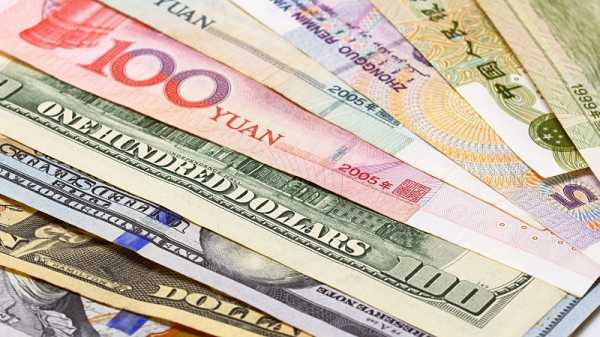
Europe
The Bank of England is expected to keep its base rate at 10 bp, but increase the amount of bonds it is buying. While two dissents last month favored a GBP100 bln increase, many expect a larger amount to be agreed upon shortly. Note that the earlier this week, the Bank of Japan boosted the zero-rate loans it will make to corporations from JPY75 trillion to JPY110 trillion. The Federal Reserve announced the launching of the Main Street lending facility for small and medium-sized businesses, and its corporate bond-buying program would include individual issues (not just ETFs) according to a new index it created. And then there is the ECB.
The ECB allotted 1.31 trillion euros in its three-year targeted lending program. The three-year loans will be at a rate of minus 100 bp if certain lending targets are achieved. The loans can also be repaid after one year. Banks rolled previous loans into this new generous facility, but there was net new borrowing of 548.5 bln euros, which was a bit more than expected (~400 bln). The ECB’s balance sheet will rise by this net figure.
The Swiss National Bank left its policy rate at minus 75 bp and underscored that its main tool to counter the franc’s strength will be intervention. The euro found support near CHF1.0660, just above the low for the month near CHF1.0650 seen last week. Norway’s Norges Bank also did not change policy and indicated that it anticipated neither asset purchases nor negative rates. However, the forward guidance it provided implies no change in rates for two years. Separately, recall that the central bank sells krone every day. Here in June, it sells NOK2.3 bln a day after NOK2.1 bln a day in May. The krone rallied after the central bank announcement.
The euro is trading in a 15-tick range on either side of $1.1245, where a 640 mln euro option expires today. Another option for a little more than 710 mln euros is struck at $1.1260 and also expires today. The narrowing peripheral bond premium over Germany coincides with a firmer euro. Yesterday’s high was a little below $1.13, and that may be sufficient to cap the single currency today. Sterling is slipping through $1.25 ahead of the outcome of the BOE meeting.
The week’s low was set Monday near $1.2455, but then it was above the 20-day moving average, which now is near $1.25, which is also the (50%) retracement objective of the rally since May 25. The next retracement is near $1.2415, but we suspect sterling will stabilize after the BOE meeting.
America
The US formally announced it was withdrawing from negotiations on efforts to coordinate a digital tax. It is important because it is a front in the US-Europe trade confrontation that is simmering below the surface. It erupted recently as part of the US decision to withdraw troops from Germany. The geopolitical signal was exaggerated. The US troops act as a tripwire, and the precise number is not so important. The importance of the move lies in how it was done (unilaterally) and the reasons (German not respecting its commitment to boost NATO spending, the gas pipeline from Russia, and unspecified German trade practices).
Most countries considering a digital tax are in Europe, but there are a few, including India, which broadened theirs a couple months ago, Indonesia, and Brazil. The US appears to be blocking efforts to coordinate under the OECD. Countries want to tax internet companies based on the sales within their borders and have a minimum global tax to minimize incentives for tax arbitrage.
While Canada and Mexico’s calendars are light, the US reports the June Philadelphia Fed manufacturing survey, which is expected to rise for the second consecutive month, and the weekly jobless claims that will likely continue to decline from still high levels. May’s Index of Leading Economic Indicators is expected to have jumped by around 2.4%. During the session, OPEC will report is compliance assessment, and it should improve now that Iraq seems to be adhering to the agreement. Lastly, we note that as anticipated, Brazil delivered a 75 bp rate cut yesterday and seemed to suggest that there was still room for another small cut. Talks between Argentina and its creditors stalled again.
The US dollar continues to trade within Tuesday’s range against the Canadian dollar (~CAD1.3505-CAD1.3625). The week’s high was set on Monday, near CAD1.3685. The intraday technicals suggest the greenback’s upside may be favored in the early North American activity. Meanwhile, the US dollar is near the middle of this week’s range against the Mexican peso (~MXN21.8950-MXN22.75), and that range is likely to hold.
Lastly, turning to the S&P 500, we note that the gap created by the lower opening a week ago remains unfilled and casts a pall over the market. The gap extends to 3181.50. Also adding to the technical caution is the fact that the five-day moving average has slipped below the 20-day moving average for the first time since early April, illustrating the corrective/consolidative phase it has entered.
For a look at all of today’s economic events, check out our economic calendar.
This article was written by Marc Chandler, MarctoMarket.
"difficult" - Google News
June 18, 2020 at 05:30PM
https://ift.tt/37GQeLR
Markets Finding it Difficult to Rebuild Bullish Momentum - FX Empire
"difficult" - Google News
https://ift.tt/2VWzYBO
https://ift.tt/3d5eskc
Bagikan Berita Ini















0 Response to "Markets Finding it Difficult to Rebuild Bullish Momentum - FX Empire"
Post a Comment